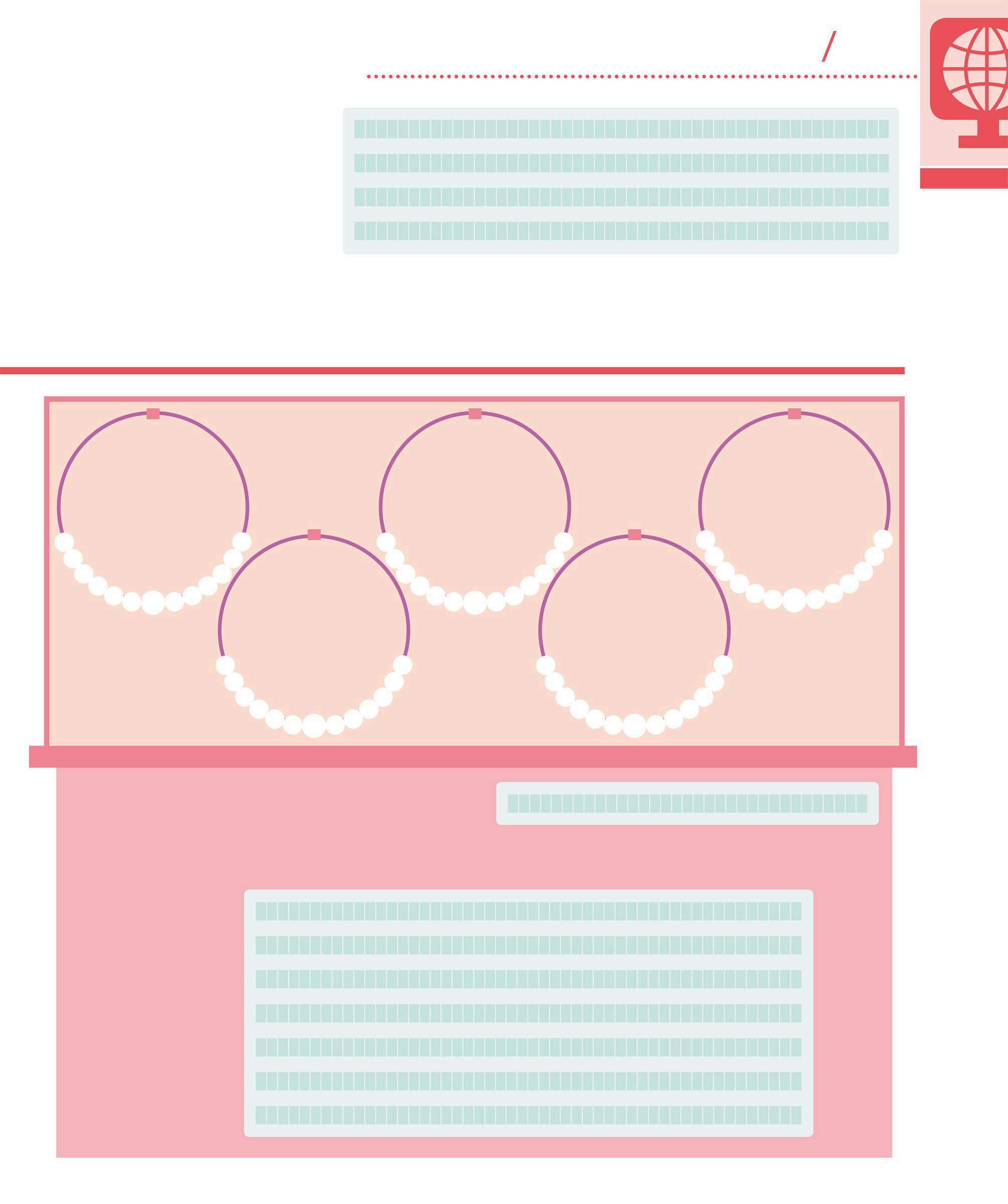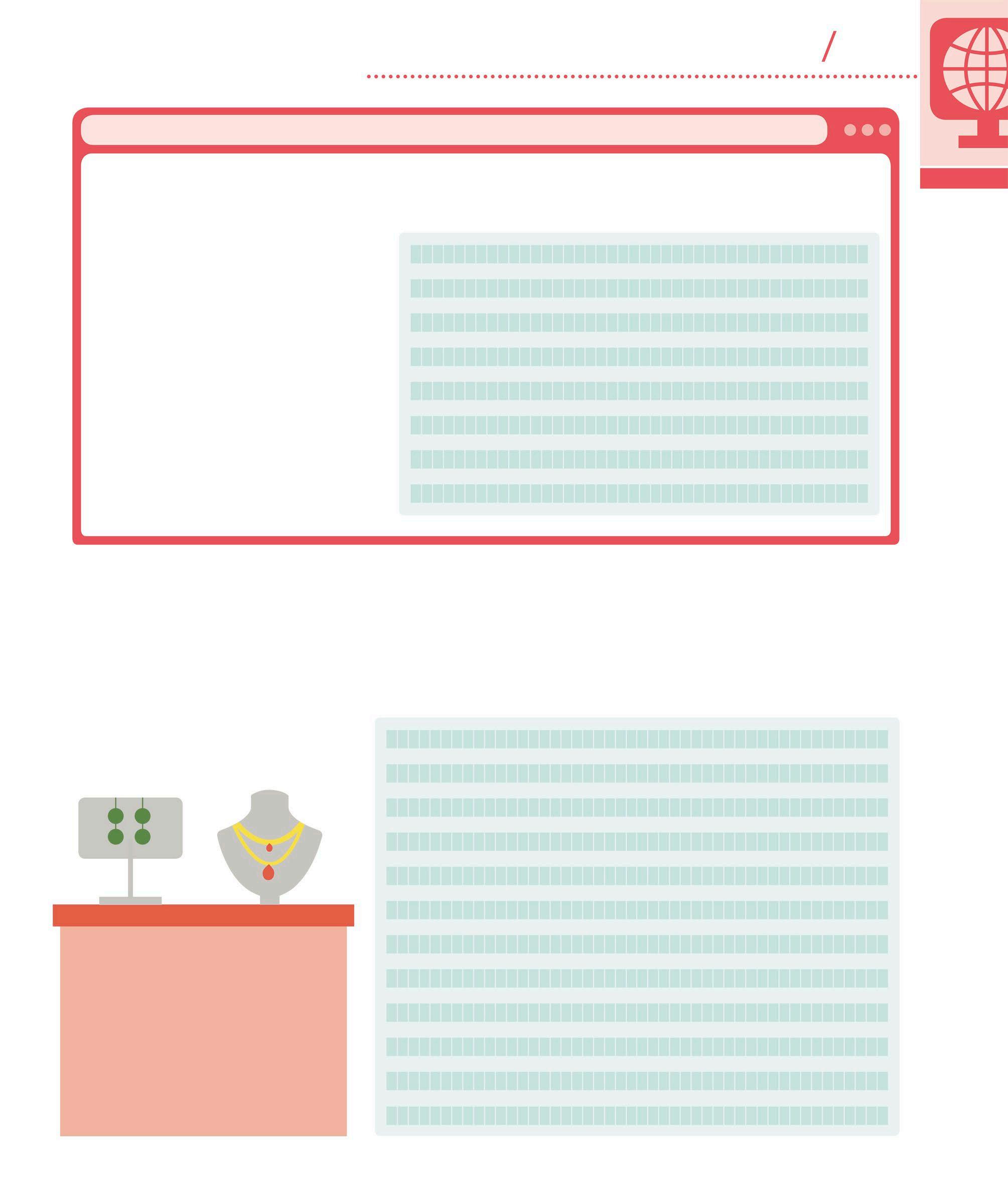6 minute read
Variables and data types
Variables are containers that store data. When JavaScript code runs, these variables can be compared and manipulated. A variable can contain different types of data, and logical operations (see pp.270–71) should only be performed with variables of the same data type.
Primitive data types
A primitive data type is a simple data value that is not an object or a method. There are three main primitive data types in JavaScript – numbers, Booleans, and strings. Data types do not need to be explicitly stated at the time of declaring a variable (see right); JavaScript automatically infers them from the code.
$250 $150
Numbers
Unlike other programming languages, JavaScript does not distinguish between integers (whole numbers without a decimal) and floating point numbers (numbers with a decimal). All numbers in JavaScript are treated as floating point numbers.
Booleans
Similar to Scratch and Python, Boolean variables in JavaScript also contain only two possible values – true or false. As the result of every logical operation is a Boolean value, these variables determine the flow of a program.
var price = 250;
Number values do not have quotation marks around them
GOLD SILVER
var isThisGold = true
Boolean values do not have quotation marks around them
Declaring variables
It is important to declare and initialize a variable before it can be used in a script. Initialization means to assign a value to the variable. It allows JavaScript to determine the data type that the variable contains and access its value. A variable should only be declared once in a program.
var lastName = "Smith"; var fullName = firstName + " " + lastName; var firstName = "John"; console.log(fullName);
Declares the variable lastName and sets its value to Smith
Incorrect declaration
In this example, the variable firstName is used before it is declared in the code. Since its value is unclear at the time of use, the output displayed will be “undefined Smith”.
The variable firstName is used before it is declared
Template literals can contain placeholders, indicated by the dollar sign and curly brackets
string.length
Returns the number of characters in a string, starting from 1. It can be used by adding .length after the name of the string.
string. indexOf()
Finds the position of a string segment within another string. It gives the index position of the first character of the segment, starting from 0.
string.slice()
Extracts part of a string. It takes two parameters, the start and end index positions (beginning at 0), and returns the string segment between them.
string. substr()
Returns a string segment where the first input parameter is the start position and the second is the length of the segment.
string.split() Divides a string into an array of substrings. For example, if “a” is the input parameter, new substrings will be formed at every instance of the letter “a”.

Strings
Strings are data types that can store a series of characters or numbers. They have a number of useful properties and methods that are described above.
var myString = "Hello world";
String values always have quotation marks around them
Concatenating strings
As in other programming languages, strings in JavaScript can be joined together by using the plus (+) symbol. However, a better way to join, or concatenate, strings is by using the template literal notation (`). This format is easier to read and maintain than using the plus symbol.
var myBook = { title: "Great Expectations", format: "paperback", }; var myBookDetails = `Title: ${myBook.title} Format: ${myBook.format}`; console.log(myBookDetails);
title is a string value Template literals are enclosed within back-tick characters instead of quotation marks
Non-primitive data types
Primitive data types in JavaScript can be grouped together to form composite data types. These non-primitive data types help organize variables into meaningful data structures that facilitate effective processing of the data. They are also called “reference variables”, because they give the location of where the data is stored.
A JavaScript array value is always surrounded by square brackets
Arrays
An array is a single variable that contains a list of values. These may be strings, numbers, and even objects. Each array item can be accessed by its index position. Similar to strings, the index of the first item in an array is 0, the second is 1, and so on.
var jewellery = ["Locket","Earring","Ring"];
This array contains three strings Index value of Earring is 1
Sorting items in an array
Arrays contain a method called sort that arranges the items of an array in alphabetical order. This method, however, does not order numbers correctly. To sort numbers, you need to add a comparison function to the sort method. For example, array.sort(compareFunction)
A
1 B
2 C
3
Array length
The length of an array returns the number of items in the array. As in strings, the length of an array also starts from 1, and not from 0.

1 2 3
Array index
The value of an item in an array can be obtained by its index, using the syntax value = array[index]. To update an array item by its index use the syntax array[index] = newValue
Adding items to an Array
Items can be added to an existing array using the push method. Though it is possible to add an item to an array by directly calling the array index, it is easier to use the push method.
SPREAD SYNTAX
The push method adds items to an array one at a time. To add all the items in one go, use the spread syntax (...). Not only does this allow multiple new items to be added all at once, it is also possible to decide whether these should be added before or after the existing array items.
Looping through an Array
It is possible to access all the items in an array by using a for loop (see p.274). The loop counter loops over every item in the array, starting from 0 to the number of items in the array.
VARIABLE SCOPE
The scope of a variable describes where in the code the variable can be accessed from. JavaScript has only two kinds of scope – local variables and global variables. Local variables are declared in a function and can only be accessed from within that function. Global variables are declared outside a function and have a global scope. They can be accessed from anywhere in the HTML document.
Global variable
In this example, the variable firstName is declared before the function and has global scope. It can be accessed from inside a function as well as outside of it.
Declares firstName with a global scope firstName and lastName are available inside the function because they have global scope
var firstName = "John"; var lastName = "Smith"; function getFullName() { var result = firstName +
" " + lastName; return result; } console.log(getFullName());
JavaScript objects
A JavaScript object is a variable that has a set of properties made up of primitive data types. This way of packaging data is known as the Json data format. This format has become the primary format for packaging and transmitting data in web applications as it is easy to use and process.

Each property is separated by a comma
The list of properties is surrounded by curly brackets
Json object with mixed property types
In this example, the Json object contains properties that have different data types. The data type of each property is set when the value is assigned to the variable.
var person = { firstName: "John", lastName: "Smith",
age: 39, hasDrivingLicense: true, education: [ "Primary School", "High School", "BA Degree" ] }
The property key and value are separated by a colon If the value is an array, it must be surrounded by square brackets
If the value is a string, it must be surrounded by quotation marks











